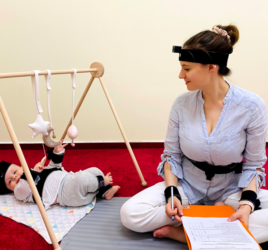
A Bridge Between Interpersonal Synchronization and Personality
The social and interconnected nature of humans has captivated researchers from diverse fields such as behavioral and cognitive sciences. In dyadic interactions (interactions between two individuals) we constantly constrain, restrict and co-regulate each other’s behavior. Relevant elements of this reciprocal process remain hidden from our conscious awareness (Galbusera et al., 2019). Moreover, the connections between interpersonal behavior and higher-order constructs such as personality can help us to understand differences in the way we interact with other people. But, is it possible to capture interpersonal dynamics and individual differences from embodied measurements?
The research group integrated by Ralf Cox, PhD., Bertus Jeronimus, PhD., Saskia Kunnen, PhD., and Nicol Arellano-Véliz (Ph.D. candidate), is studying interpersonal synchronization in an experimental setting. We are focusing on the way individuals synchronize their body movements and heart rate in a conversation. Particularly, how personality differences can be linked to differences in interpersonal synchronization and the way that individuals perceive their interactions.
But what is Synchronization and how could be related to Personality?
Interpersonal synchronization is a particular phenomenon of interpersonal dynamics that requires the coupling or coordination of several elements in time (Tschacher et al., 2018; Nowak et al., 2020). For instance, when two individuals dance or walk together coordinating their movements in time. In the case of our research, the elements we considered take the form of body movement and heart rate variability. We are studying dyadic interactions based on behavioral imaging techniques, i.e., “Motion Energy Analysis” (Tschacher et al., 2018), from which we can quantify the strength of interpersonal synchronization of body movement. Additionally, we added a physiological measurement –heart rate variability, in order to create a multimodal design.
Interpersonal synchronization is a particular phenomenon of interpersonal dynamics that requires the coupling or coordination of several elements in time (Tschacher et al., 2018; Nowak et al., 2020). For instance, when two individuals dance or walk together coordinating their movements in time.
By understanding the interacting partner as the immediate environment or situation, we expect personality to play a differentiating role in dyadic interactions (Vallacher et al., 2002). Accordingly, we matched participants with different personality profiles in our experimental study (e.g., high/low in Extraversion, high/low in Agreeableness) to have a conversation. We expected differentiated outcomes between different dyadic compositions. For example, hypothesized that some dyads would synchronize their body movements and heart rate more than others, and we also expected differentiated outcomes in terms of affect and the perception of the interactions. We expected that similar dyads –e.g., two extroverts or two agreeable individuals– would have greater amounts of interpersonal synchronization. We expected this effect in body movement and heart rate, accompanied by a positive perception of the interaction (e.g., more enjoyment and positive affect, Cuperman & Ickes, 2009). While we expected quite the opposite for two low agreeable individuals.
By understanding the interacting partner as the immediate environment or situation, we expect personality to play a differentiating role in dyadic interactions (Vallacher et al., 2002).
We think that the way two individuals synchronize could help us to understand personality interactions and how humans flexibly adjust to interpersonal situations (e.g., Lakey et al., 2021). In doing so, we acknowledge the individual as an agent in the environment that inhabits. In this case, the environment takes the form of another human being (Thompson & Varela, 2001; Galbusera et al., 2019).
We think that the way two individuals synchronize could help us to understand personality interactions and how humans flexibly adjust to interpersonal situations.
Finally, we believe that interpersonal synchronization linked to psychological constructs like personality can help researchers to understand how individuals organize their worlds and perceive each other in social contexts.
References
Arellano-Véliz, N. A., Jeronimus, B. F., Kunnen, S. & Cox, R. F. A. (2021, October 26). Others as the immediate environment: A multimodal approach to the interpersonal dynamics of personality. https://doi.org/10.17605/OSF.IO/KPFQW
Cuperman, R. & Ickes, W. (2009). Big Five Predictors of Behavior and Perceptions in Initial Dyadic Interactions: Personality Similarity Helps Extraverts and Introverts, but Hurts “Disagreeables”. Journal of Personality and Social Psychology, 97(4), 667-684. http://doi.org/10.1037/a001574
Galbusera, L., Finn, M.T.M., Tschacher, W. & Kyselo, M. (2019). Interpersonal synchrony feels good but impedes self-regulation of affect. Nature Scientific Reports, 9(14691). https://doi.org/10.1038/s41598-019-50960-0
Lakey, B., Hubbard, S.A., Brummans, J., Obreiter, A. & Perrin, P. (2021). The Relational Regulation of Within-Person Variation in Personality Expression. Journal of Personality, 00, 1-15. http://doi.org/10.1111/JOPY.12659
Nowak, A., Vallacher, R., Praszkier, R., Rychwalska, A. & Zochowski, M. (2020). In Sync. The Emergence of Function in Minds, Groups and Societies. Springer Nature Switzerland.
Thompson, E. & Varela, F. J. (2001). Radical embodiment: neural dynamics and consciousness. Trends in Cognitive Sciences, 5, 418–425. https://doi.org/10.1016/s1364-6613(00)01750-2
Tschacher, W., Ramseyer, F. & Koole, (2018). Sharing the now in the social present: Duration of nonverbal synchrony is linked with personality. Journal of Personality, 86(2), 129-138. http://doi.org/10.1111/jopy.12298
Vallacher, R.R., Read, S.J., & Nowak, A. (2002). The Dynamical Perspective of Personality and Social Psychology. Personality and Social Psychology Review, 6(4), 264-273. https://doi.org/10.1207%2FS15327957PSPR0604_01
Note: Featured Image: Two Teenage Girls Kneeling on Floor Smiling and Looking at Each Other by Марина Вотинцева. Creative Commons License.




